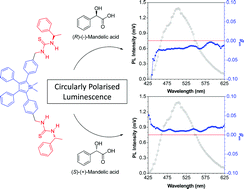Complexation-induced circular dichroism and circularly polarised luminescence of an aggregation-induced emission luminogen†
Abstract
We here report a molecule with chiral recognition capability by a mechanism of complexation-induced circularly polarised luminescence (CPL) in the solid thin film state. A molecule (1) containing the luminogenic unit silole and chiral phenylethanamine pendants is synthesized and characterized with standard spectroscopic methods. In a solution of 1, no circular dichroism (CD) or fluorescence emission are observed. When aggregated into nanoparticles in a poor solvent, fluorescence is turned on but CD is still silent. When complexed with chiral acids to form a thin film, molecule 1 becomes CD-active and strongly fluorescent, showing simultaneous complexation-induced CD (CICD) and aggregation-induced emission (AIE) effects. The assemblies of 1 with different enantiomers of mandelic acid emit distinctly handed circularly polarised light and display CPL dissymmetry factors with absolute value around 0.01. This work provides a new platform for creating molecular functional materials with solid-state chiral sensing ability through reading CPL output signals.


 Please wait while we load your content...
Please wait while we load your content...